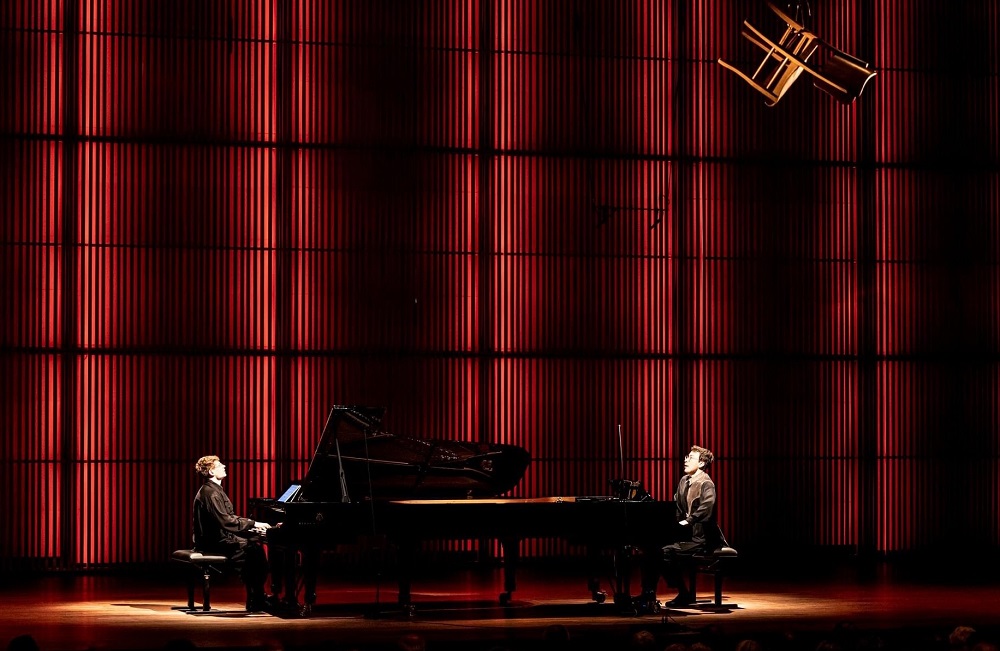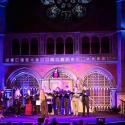Shortly before his death, Rachmaninov proposed recording the two-piano version of his swansong Symphonic Dances with Vladimir Horowitz. A curse on that RCA executive who turned the offer down. What amazes is how much pianistic magic can make up for the orchestral wizardry of the more familiar incarnation. The Kolesnikov-Tsoy duo is the one to redisover it now, and they did the same for Mikhail Pletnev’s recreative genius in music from Prokofiev’s Cinderella.
The pairing makes perfect sense, as in irrational non-sense, where everything unpredictable flies and soars. There’s contrast in these two scores from the 1940s, though both boast spectral waltzes and flashing grotesqueries; Rachmaninov, always evading the label of conservatism, tends to mine arpeggios and portions of scales where Prokofiev continues the harmonic sleights of hand and mysteries very much parallel – as this context showed – with the edgy genius of the three so-called “war” piano sonatas, 6-8. In both, there were moments of rare magic as each pianist conducted himself with one hand and played a single line with the other: Tsoy, taking most of the melodies, in a metaphysical preparation for Cinderella’s meeting with the Prince; Kolesnikov using the sustaining pedal to suspend time as Rachmaninov’s first dance moves into its nostalgic central reverie.
You’d think this would need the woodwind wizardry of the orchestral version, led by the alto saxophone, but not so; the two pianists created hypnotic magic of their own as Rachmaninov’s homesick soulfulness soars. They were to go even deeper in the encore, “Larmes” (“Tears”) from the First Suite, mining with an initial minimalism the four weeping notes of the bells of Novgorod with which the composer grew up, and proof that the profundity was already there in the imagination of a phenomenal nineteen year old.  But the demonism to compound the melancholy came later, and devils certainly swarm around the stamping rituals and the swirling central Valse triste of the Symphonic Dances. Full profile was needed here for crisp chords and driving syncopations, verging on Rite of Spring territory as Rachmaninov moves into a quotation from his Vespers just before the hair-raising conclusion (Kolesnikov and Tsoy have their own, uniquely tailored take on Stravinsky’s transcription).
But the demonism to compound the melancholy came later, and devils certainly swarm around the stamping rituals and the swirling central Valse triste of the Symphonic Dances. Full profile was needed here for crisp chords and driving syncopations, verging on Rite of Spring territory as Rachmaninov moves into a quotation from his Vespers just before the hair-raising conclusion (Kolesnikov and Tsoy have their own, uniquely tailored take on Stravinsky’s transcription).
If some of the Cinderella vortices verged on a manic blur, but behind a scrim – the sound-world here very specific – there was also dazzling articulation, not least in the Prince’s galop around the world, followed by some of Pletnev’s most successful stitiching-together. He wrote this for himself and Martha Argerich; it’s a perfect storytelling balance between melancholy moonshine and satirical angularity, and much more effective than Prokofiev’s own “Pieces for [solo] Piano from Cinderella”
As Kolesnikov reached inside his instrument to bolster chimes at midnight, I wondered if this was an extra effect added by the present duo; apparently it belongs to the Pletnev original, but the two added more to Rachmaninov’s transcription, making this one for the ages. I wish I could have been present at the movers/shakers’ latest Ragged Music Festival, seven concerts in Amsterdam (pictueed above) with the usual roster of equal star musicians, but this was a compensatory vision. It will resonate for weeks and months to come.












Add comment